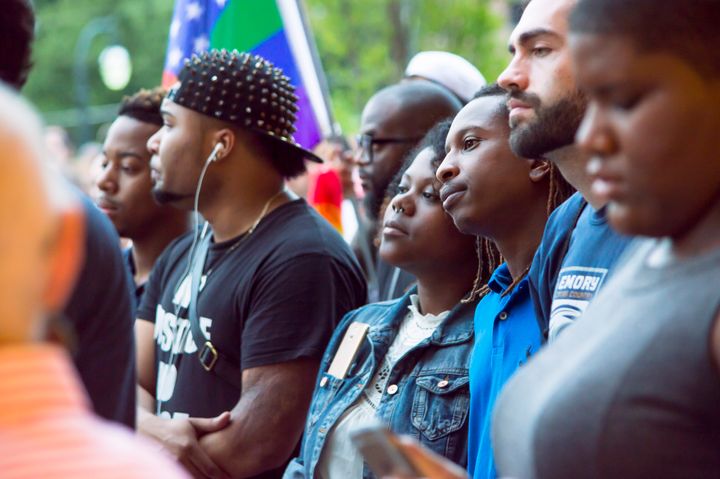
In the movie Moonlight, Chiron approaches Terrel, a bully who coerced Chiron’s friend Kevin to beat Chiron up and smashes him over the head with a chair. I am shaken by this scene every time I watch the film because there’s no clear victim-perpetrator narrative to tag onto – everyone involved loses. Equally disturbing is the fact that scenes like this play out every day in schools across the country.
Recently, an altercation occurred in a Bronx classroom leaving one student dead and another severely injured. We extend our sincere condolences to the loved ones of the victims and our prayers are with them. Forever changed are the lives of those who witnessed this traumatic incident, those who loved these two young people, as well as the assailant in this school tragedy who was allegedly tormented by racist and anti-LGBTQ harassment, who will now be prey to the criminal justice system. Our deepest sympathy is with all of them. Sympathy, however, is not enough. We have a responsibility to take action to ensure that all young people are safe.
This school tragedy underscores the importance of creating safe and inclusive school climates where harassment and violence based on actual or perceived race, gender, sexual orientation, religion, and other biased attitudes are not tolerated. We must ensure that young people are safe, but also respected. We have a lot of work to do. According to the 2015 GLSEN National School Climate Survey, the vast majority of LGBTQ students (85%) experienced verbal harassment and 27% were physically harassed.
When compared nationally, New York City schools have been ahead of the curve in implementing progressive policies to address school bullying. For example, The Dignity for All Students Act, which went into effect in 2012, aims to protect New York State public school students from harassment and bullying by focusing on prevention, education and improving school climate. However, as the old adage goes, laws are only as good as their enforcement. Too often those who are the victims of harassment and bullying are only further victimized by inaction on behalf of their teachers, school administrators, counselors, and other institutions.
In that same survey, 58% of LGBTQ students who were harassed or assaulted in school did not report the incident to school staff, most commonly because they doubted that effective intervention would occur or the situation could become worse if reported. Of those that did report an incident, 64% said that school staff did nothing in response or told the student to ignore it. The choice in how to respond to a young person’s plight might mean the difference in how they choose to respond to a bully or bullying behavior. Educators, faculty, and staff who are in the trenches with these young people every day play a significant role, and can be the difference between a negative outcome or can lead the way towards positive ones.
All of this takes resources. Organizations like GLSEN provide professional development training to assist schools in developing the knowledge and skills needed to create and sustain a safe, inclusive, respectful, and healthful environment for all students. Such trainings by certified experts should be part of required professional development in schools. As such, educators become equipped with the tools to handle situations when and before they arise.
It is also important to recognize and acknowledge the structural barriers that fuel violence and bullying in schools that often leads to the criminalization of youth. These barriers include housing instability, lack of access to quality food, health care needs, and lack of parental involvement. Black youth and other youth of color, LGBTQ youth, and youth with disabilities are disproportionately disciplined more harshly than other students and referred to law enforcement more often, even for minor infractions such as talking back or being late to class. In fact, 70% of the students involved in school-related arrests or referred to law enforcement are Black or Hispanic.[i] These young people are more likely to drop out or be pushed into the criminal justice system in what is often referred to as the school-to-prison pipeline. Existing research, data, and public policy debates often fail to address the degree to which black LGBTQ youth face risks that are both similar to and different from those faced by other students.
After an incident like this, we must ask ourselves this question: what could we have done differently? How did we fail these young people? And what can we do to ensure that something like this never happens again? Unfortunately, we cannot go back but we can use this as an opportunity to learn from our mistakes and do better by our young people to implement plans to reduce the likelihood of these traumatic events. Some steps include:
· Ensure that all staff members take immediate action when bullying is observed,
· Make referrals to counseling and/or mental health staff, when appropriate, to work with students who are bullied and with students who bully,
· Support restorative and trauma-informed discipline rather than punitive options,
· Support the creation of student-led GSA clubs,
· Train staff members on working with diverse student populations including LGBTQ students,
· Encourage parent involvement,
· LGBTQ cultural competence training that also address the realities and vulnerabilities of queer and trans students of color,
· Host a screening of the film Moonlight with a discussion of the School-to-Prison Pipeline, and
· Encourage school board members to get involved.
We owe it to these students and families to make sure that we work together to prevent similar tragedies from occurring in the future. Most importantly, we should encourage our young people to be their best selves, and support each other in doing the same.
[i] Rudd, T. (2014). Racial disproportionality in school discipline: Implicit bias is heavily implicated. Kirwan Institute. Retrieved online from, http://kirwaninstitute.osu.edu/wp- content/uploads/2014/02/racial-disproportionality-schools-02.pdf
